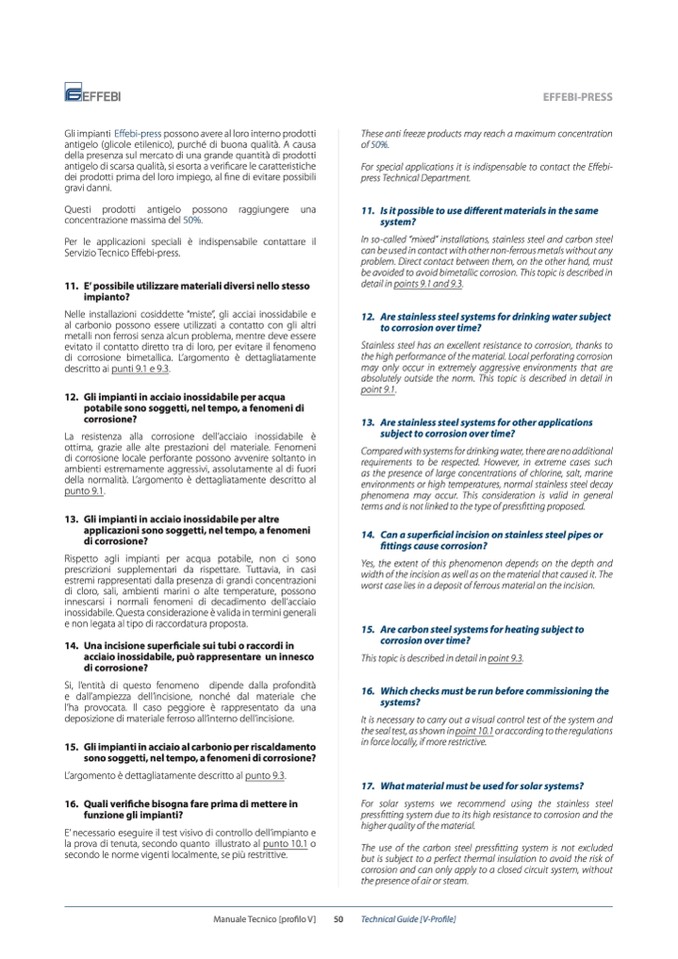
Gli impianti Effebi-press possono avere al loro interno prodotti
antigelo (glicole etilenico), purché di buona qualità. A causa
della presenza sul mercato di una grande quantit
à di prodotti
antigelo di scarsa qualità, si esorta a verificare le caratteristiche
dei prodotti prima del loro impiego, al
fine di evitare possibili
gravi danni.
Questi prodotti antigelo possono raggiungere una
concentrazione massima del 50%.
Per le applicazioni speciali è indispensabile contattare il
Servizio Tecnico Effebi-press.
11. E’ possibile utilizzare materiali diversi nello stesso
impianto?
Nelle installazioni cosiddette “miste”, gli acciai inossidabile e
al carbonio possono essere utilizzati a contatto con gli altri
metalli non ferrosi senza alcun problema, mentre deve essere
evitato il contatto diretto tra di loro, per evitare il fenomeno
di corrosione bimetallica. L’argomento è dettagliatamente
descritto ai punti 9.1 e 9.3.
12. Gli impianti in acciaio inossidabile per acqua
potabile sono soggetti, nel tempo, a fenomeni di
corrosione?
La resistenza alla corrosione dell’acciaio inossidabile è
ottima, grazie alle alte prestazioni del materiale. Fenomeni
di corrosione locale perforante possono avvenire soltanto in
ambienti estremamente aggressivi, assolutamente al di fuori
della normalità. L’argomento è dettagliatamente descritto al
punto 9.1.
13. Gli impianti in acciaio inossidabile per altre
applicazioni sono soggetti, nel tempo, a fenomeni
di corrosione?
Rispetto agli impianti per acqua potabile, non ci sono
prescrizioni supplementari da rispettare. Tuttavia, in casi
estremi rappresentati dalla presenza di grandi concentrazioni
di cloro, sali, ambienti marini o alte temperature, possono
innescarsi i normali fenomeni di decadimento dell’acciaio
inossidabile. Questa considerazione
è valida in termini generali
e non legata al tipo di raccordatura proposta.
14. Una incisione superficiale sui tubi o raccordi in
acciaio inossidabile, può rappresentare un innesco
di corrosione?
Si, l’entità di questo fenomeno dipende dalla profondità
e dall’ampiezza dell’incisione, nonché dal materiale che
l’ha provocata. Il caso peggiore
è rappresentato da una
deposizione di materiale ferroso all’interno dell’incisione.
15. Gli impianti in acciaio al carbonio per riscaldamento
sono soggetti, nel tempo, a fenomeni di corrosione?
L’argomento è dettagliatamente descritto al punto 9.3.
16. Quali verifiche bisogna fare prima di mettere in
funzione gli impianti?
E’ necessario eseguire il test visivo di controllo dell’impianto e
la prova di tenuta, secondo quanto illustrato al punto 10.1 o
secondo le norme vigenti localmente, se più restrittive.
EFFEBI-PRESS
These anti freeze products may reach a maximum concentration
of 50%.
For special applications it is indispensable to contact the Effebi-
press Technical Department.
11. Is it possible to use different materials in the same
system?
In so-called “mixed” installations, stainless steel and carbon steel
can be used in contact with other non-ferrous metals without any
problem. Direct contact between them, on the other hand, must
be avoided to avoid bimetallic corrosion. This topic is described in
detail in points 9.1 and 9.3.
12. Are stainless steel systems for drinking water subject
to corrosion over time?
Stainless steel has an excellent resistance to corrosion, thanks to
the high performance of the material. Local perforating corrosion
may only occur in extremely aggressive environments that are
absolutely outside the norm. This topic is described in detail in
point 9.1.
13. Are stainless steel systems for other applications
subject to corrosion over time?
Compared with systems for drinking water, there are no additional
requirements to be respected. However, in extreme cases such
as the presence of large concentrations of chlorine, salt, marine
environments or high temperatures, normal stainless steel decay
phenomena may occur. This consideration is valid in general
terms and is not linked to the type of pressfitting proposed.
14. Can a superficial incision on stainless steel pipes or
fittings cause corrosion?
Yes, the extent of this phenomenon depends on the depth and
width of the incision as well as on the material that caused it. The
worst case lies in a deposit of ferrous material on the incision.
15. Are carbon steel systems for heating subject to
corrosion over time?
This topic is described in detail in point 9.3.
16. Which checks must be run before commissioning the
systems?
It is necessary to carry out a visual control test of the system and
the seal test, as shown in point 10.1 or according to the regulations
in force locally, if more restrictive.
17. What material must be used for solar systems?
For solar systems we recommend using the stainless steel
pressfitting system due to its high resistance to corrosion and the
higher quality of the material.
The use of the carbon steel pressfitting system is not excluded
but is subject to a perfect thermal insulation to avoid the risk of
corrosion and can only apply to a closed circuit system, without
the presence of air or steam.
Manuale Tecnico [profilo V]
50
Technical Guide [V-Profile]

